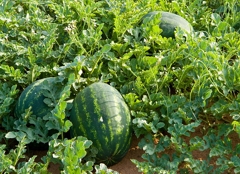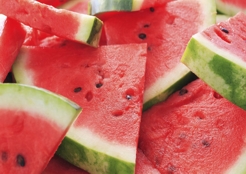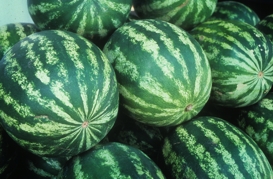| Annual / Vegetables - Fruits / Sweet Watermelon - Jubilee - Water melon |
|
|
|
|
| |
|
Plant name - Watermelon
|

|
|
 |
|
 |
| Common name - Citrullus lanatus
|
| Plant type - Fruit |
| Vegetation type -
Annual |
| Growth rate - fast |
| Leaf / Flower color
- Green / Yellow |
| Other names - Citrullus lanatus |
| |
| Description : |
Watermelon (Citrullus lanatus var. lanatus, family Cucurbitaceae) is a vine-like (scrambler and trailer) flowering plant originally from southern Africa.
Its fruit, which is also called watermelon, is a special kind referred to by botanists as a pepo, a berry which has a thick rind (exocarp) and fleshy center (mesocarp and endocarp).
Pepos are derived from an inferior ovary, and are characteristic of the Cucurbitaceae.
The watermelon fruit, loosely considered a type of melon – although not in the genus Cucumis – has a smooth exterior rind (usually green with dark green stripes or yellow spots) and a juicy, sweet interior flesh (usually deep red to pink, but sometimes orange, yellow, or white).
.
|
| |
| Growing Instructions : |
* Start by gathering your containers. Used, cleaned yogurt cups are great starter pots, as are the small individual servings of ice cream cups. Or you can get small pots from a garden center, but for economical gardeners recycling those snack cups is the best way! You will need as many as the number of plants you want to grow.
* Fill each container with potting soil. Fill the containers half to three quarters full. Using your finger or a spoon poke a hole about an inch deep and drop 2 or 3 watermelon seeds in each hole. One hole per container!
* Cover your seeds with soil and water the soil til it's moist. Be careful not to over water these small containers as this could cause the seeds to rot and never grow. If you over water them, try sitting them in the sun for a few days and letting the soil dry out. When it's completely dry add a little water and wait, hopefully your seed will have survived!
* Once the seeds are planted and watered place them in a warm environment to speed up the sprouts. A great place for this is on top of your refrigerator! Leave them here until they sprout, which can take several weeks, and then you can move them to a sunny spot in your house.
* Once sprouted, continue to water as needed until they've grown a bit. You may have several sprouts in each container. After they start to really grow you'll want to thin them back to just one or two sprouts. Do this by snipping the excess plants off near the soil. The remaining plants will grow stronger and bigger!
* Finally, once your plants are big enough to survive outside (and the weather is warm enough) plant them in a sunny spot and water them regularly. You'll be enjoying those juicy watermelons all summer long!
|
| |
|
|
|
|
|
